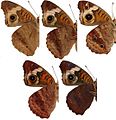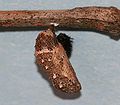- Junonia coenia
-
Common Buckeye 
Conservation status Not evaluated (IUCN 3.1)Scientific classification Kingdom: Animalia Phylum: Arthropoda Class: Insecta Order: Lepidoptera Family: Nymphalidae Genus: Junonia Species: J. coenia Binomial name Junonia coenia
Hübner, 1822The (Common) Buckeye (Junonia coenia) is a butterfly in the family Nymphalidae. It is found in southern Manitoba, Ontario, Quebec, and Nova Scotia and all parts of the United States except the northwest, and is especially common in the south, the California coast, and throughout Central America and Colombia. The sub-species Junonia coenia bergi is endemic to the island of Bermuda.
Its habitat is open areas with low vegetation and some bare ground. This species and its relatives were placed formerly in the genus Precis.
Contents
Description
The bold pattern of eyespots and white bars on the upper wing surface is distinctive in much of its range, though compare related species in the same genus. (These are Mangrove Buckeye, Junonia evarete and Tropical Buckeye, Junonia genoveva, formerly considered one species, the Smoky Buckeye, Junonia evarete.) The eyespots likely serve to startle or distract predators, especially young birds. The species has many flights throughout the year, with mostly northward migrations for the summer. Much of the northern United States is only colonized in the fall from southern populations. Some of the later broods move southwards in the fall. Common buckeyes exhibit seasonal polyphenism, the summer version of the butterfly has light yellowish ventral wings and is called "linea". The Fall morph has pink ventral wings, and is called the "rosa" morph.
Diet
Adults feed on nectar and also take fluids from mud and damp sand. Males perch on bare ground or low plants, occasionally patrolling in search of females, but they are not territorial. The female lays eggs singly on buds or the upper side of leaves. The caterpillars are solitary and feed on the foliage, flowers, and fruits of the host plant. A variety of (typically) herbaceous plants are used, including especially plants in the snapdragon family (Scrophulariaceae). These include snapdragon (Antirrhinum), toadflax (Linaria), and Gerardia. Caterpillars also feed on plants of the plantain family, such as Plantago; and the Acanthus family including ruellia (Ruellia nodiflora). Larvae feed singly. Adults and some larvae overwinter in southern areas. The pupa may not have a resting phase (diapause), as in many other butterflies.
The Common Buckeye was featured on the 2006 United States Postal Service 24-cent postage stamp.
Gallery
See also
- Smoky Buckeye
- Meadow Argus (Junonia villida)
- Monarch Butterfly
References
- Jim P. Brock, Kenn Kaufman (2003). Butterflies of North America. Boston: Houghton Mifflin. ISBN 0-618-15312-8.
- Darby, Gene (1958). What is a Butterfly. Chicago: Benefic Press. p. 8.
- Jeffrey Glassberg (1999). Butterflies through Binoculars : The East A Field Guide to the Butterflies of Eastern North America. New York: Oxford University Press. ISBN 0-19-510668-7.
- James A. Scott (1986). The Butterflies of North America: A Natural History and Field Guide. Stanford, California: Stanford University Press. ISBN 0-8047-2013-4.
- Bermuda Department of Conservation Services, Buckeye Butterfly page
- Common buckeye on Bugguide.net
- Butterflies of North America
- Carolina Nature--accessed 8 May 2006
External links
 Media related to Junonia coenia at Wikimedia Commons
Media related to Junonia coenia at Wikimedia Commons- common buckeye on the UF / IFAS Featured Creatures Web site
- Common Buckeye, Butterflies of Canada
Categories:- Junonia
- Butterflies and moths of North America
- Butterflies of Canada
Wikimedia Foundation. 2010.




